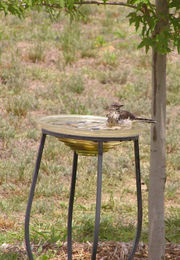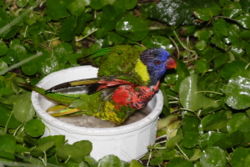
Photo of a mockingbird taking a bath in a glass
bowl bird bath. The bottom of the bowl is
partially filled with smooth pebbles in order to
make it shallow enough for the birds.
A bird bath is
essentially a man-made puddle on a pedestal with a
shallow basin filled with water for bathing and drinking.
Used in combination with
bird feeders and species-appropriate
shrubs and trees, a bird bath is a powerful attraction for
birds, especially during droughts.
Design and construction

Lorikeet-sized bird bath
The typical and traditional bird bath is made of molded
concrete formed in two pieces, the bowl and the pedestal.
The bowl has an indentation or socket in the base which
allows it to fit over the pedestal. The pedestal is
typically about one meter tall. Both bowl and pedestal are
decorated with reliefs. The bowl may have a shell type of
motif or a woodland rocky spring motif. The pedestal usually has a motif of vines
or tree trunks. However, birds are also attracted to simpler
designs, even a shallow plate or pie tin placed beneath a
slowly dripping water faucet will welcome birds to your
garden.
Bird baths can be made with other types of materials
including glass, metal, plastics, mosaic tile, or any other
material that can weather well and hold water. In addition
to the standard shallow container of standing water, there
are also bird baths which use a recirculating pump with
filters possibly coupled to a water supply with an automatic
valve which will keep the bird bath water cleaner and
requires less day-to-day care. Some use a solar powered pump
to recirculate the water.
A place to stand
An important feature of a bird bath that should be
considered in designing one, is a place to perch, to avoid
the risk of birds drowning. This requirement may be
fulfilled simply by making the bowl or container part
shallow enough to allow birds to perch in the water.
Another way is to add a number of clean stones inside the
bowl, to create places on which a bird might stand.
A safe feeling
Consideration should also be made to the issue of
housecats or other
predators, by placing the birdbath in a location where
the birds can see the area around it, and where there are no
hiding places for predators to lurk. This is one of the
reasons birdbaths are customarily placed on pedestals.
Maintenance
A bird bath requires maintenance. Maintenance may be as
simple as a daily quick wash and refill but it will depend
on the bird bath materials. This is important because of the
possible adverse health effects of birds drinking dirty
water or water which may have become fouled with excrement.
Fresh water is important. Concrete bird baths tend to become
mossy and require an occasional scrubbing out.
Welcoming larger birds
Larger birds, such as the
Canada goose, also enjoy baths. They may be accommodated
well by large agricultural sprinklers in a field of stubble.
The sight of several hundred or thousand large geese
"playing in the sprinklers" can be a moving experience.
Providing such a place for
migratory birds, especially in urban and suburban areas
devoid of
wetlands is an excellent way of encouraging them to
frequent an area. As wetlands become more scarce, steps such
as these can be important
conservation practices.
See also




